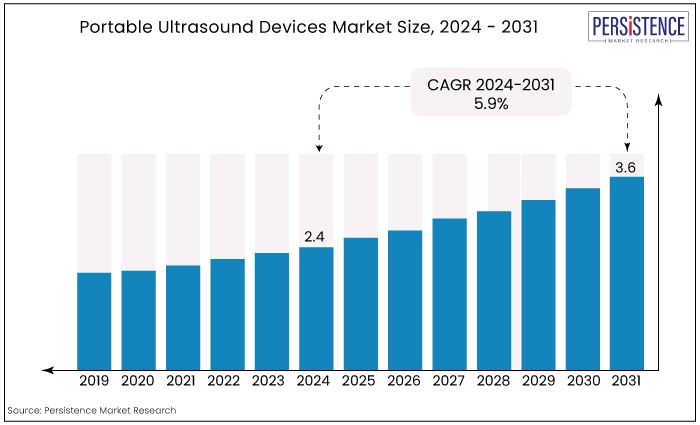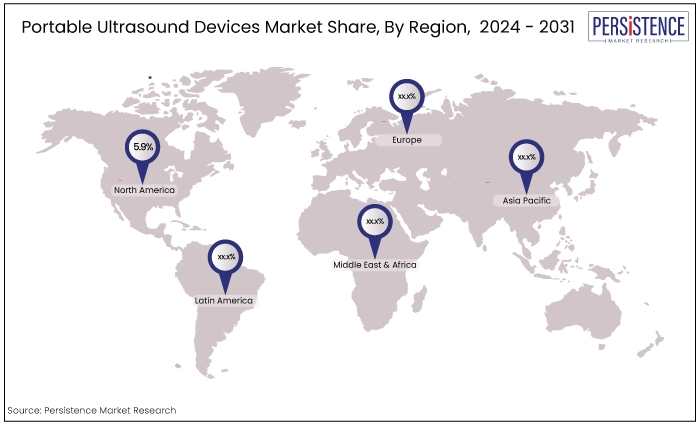Industry: Healthcare
Format: PPT*, PDF, EXCEL
Delivery Timelines: Contact Sales
Report Type: Ongoing
Report ID: PMRREP34623
The global portable ultrasound devices market is estimated to value at US$3.6 Bn by the end of 2031 from US$2.4 Bn recorded in 2024. the market is expected to secure a CAGR of 5.9 % in the forthcoming years from 2024 to 2031.
Key Highlights of the Market
|
Market Attributes |
Key Insights |
|
Portable Ultrasound Devices Market Size (2024E) |
US$2.4 Bn |
|
Projected Market Value (2031F) |
US$3.6 Bn |
|
Forecast Growth Rate (CAGR 2024 to 2031) |
5.9 % |
|
Historical Growth Rate (CAGR 2018 to 2023) |
4.8 % |
Portable ultrasound devices represent a transformative advancement in medical imaging technology, combining high-resolution imaging capabilities with unprecedented mobility.
Designed to provide immediate diagnostic information at the point of care, these devices are compact, lightweight, and often handheld or cart-based, making them ideal for use in diverse clinical settings, including hospitals, outpatient clinics, and remote or underserved areas.
The ability to deliver real-time images of internal organs, tissues, and blood flow without the risks associated with ionizing radiation positions portable ultrasound devices as a safer alternative to traditional imaging methods like X-rays, and CT scans.
Their versatility extends across a wide range of applications, from emergency and critical care to obstetrics, cardiology, and musculoskeletal assessments, thereby enhancing patient outcomes through faster diagnosis and treatment.
With the global healthcare landscape increasingly emphasizing point-of-care diagnostics and personalized care, the demand for portable ultrasound devices is expected to grow robustly, driven by continuous technological innovations and expanding healthcare infrastructure, particularly in emerging markets.

The market for portable ultrasound devices has experienced remarkable growth over the past few decades, fueled by technological advancements, increasing healthcare demands, and a shift towards more patient-centric care models.
Initially restricted to large, immobile machines in hospitals, ultrasound technology underwent a significant transformation with the advent of portable devices in the late 20th and early 21st centuries.
The innovation allowed diagnostic imaging to be brought directly to the patient's bedside, whether in emergency rooms, outpatient clinics, or remote locations.
Key drivers of this growth include the miniaturization of technology, improved battery life, and sophisticated imaging software, along with the rising prevalence of chronic diseases and the need for healthcare accessibility in underserved areas.
The future of the portable ultrasound devices market is bright, driven by the integration of these devices with telemedicine platforms, advancements in AI and ML, and expansion into new applications such as sports medicine, veterinary care, and military medicine.
The market trend towards home healthcare, spurred by an aging population and the need for chronic disease management, will further amplify demand.
Additionally, rapid economic development and healthcare infrastructure improvements in regions like Asia Pacific, and Latin America are poised to contribute significantly to market growth.
As the industry continues to innovate and expand, portable ultrasound devices are set to play an increasingly vital role in modern healthcare, providing accessible, real-time diagnostic solutions across various settings.
Incorporating AI and ML into portable ultrasound systems enhances diagnostic accuracy and efficiency. AI algorithms can assist in image interpretation, detect anomalies, and provide decision support, reducing the dependency on highly skilled operators and minimizing diagnostic errors.
The Positive Impact of Point-of-Care Testing
The rise of point-of-care testing (POCT) has significantly driven the demand for portable ultrasound devices, aligning with the broader trend towards rapid and accessible diagnostic solutions.
POCT enables quick detection of analytes near the patient, facilitating timely medical decisions and early disease diagnosis, which are crucial for improved health outcomes.
This shift towards immediate, bedside testing has underscored the importance of portable diagnostic tools that can be used in various settings, from hospitals and clinics to home care and remote areas.
Portable ultrasound devices fit seamlessly into this evolving landscape by providing real-time imaging capabilities that can be utilized at the point of care.
The ability of these devices to capture dynamic images of internal organs and blood flow without exposing patients to ionizing radiation makes them ideal for diverse applications such as emergency medicine, obstetrics, cardiology, and musculoskeletal assessments.
As the global POCT market is expected to grow significantly, with North America leading and Asia Pacific experiencing rapid expansion, the demand for portable ultrasound devices is also anticipated to surge.
Increasing Healthcare Expenditure and Access to Advanced Medical Devices
In 2021, global healthcare spending reached a record high of $9.8 trillion, accounting for approximately 10.3% of the global GDP. This surge in spending was largely fueled by increased government funding and out-of-pocket expenses due to the COVID-19 pandemic.
The substantial investment in healthcare across various nations underscores the growing prioritization of health and medical services.
Countries allocate different proportions of their GDP to healthcare, reflecting their commitment to improving health outcomes. For example, the United States dedicates around 16.57% of its GDP to healthcare, while Germany and France allocate approximately 12.65% and 12.31% respectively.
The significant expenditure facilitates the adoption of advanced medical technologies and devices, including portable ultrasound devices.
Looking ahead, as healthcare systems globally continue to prioritize technological integration and patient-centric care models, the demand for advanced medical devices like portable ultrasound devices is expected to grow.
This market trend is set to transform healthcare delivery by facilitating earlier diagnosis, personalized treatment plans, and ultimately improving overall healthcare outcomes.
Stringent Regulatory Requirement
Manufacturers seeking to introduce new devices or modify existing ones must adhere to rigorous standards set by regulatory bodies like the FDA. These requirements demand comprehensive documentation and evidence of safety and effectiveness through processes such as the 510(k) premarket notification.
The requisite involves demonstrating substantial equivalence to predicate devices and complying with specific guidelines on acoustic output levels, safety testing, and performance standards.
Moreover, the FDA's enforcement policies for modifications to legally marketed devices add another layer of complexity. Manufacturers must carefully navigate these policies to determine whether changes to their devices require a new 510(k) submission.
The FDA’s reinforcement includes considerations of intended use, mode of operation, acoustic output levels, and adherence to recognized standards like IEC 60601-2-37 for output display.
Non-compliance or failure to meet these standards can delay market entry, increase development costs, and potentially lead to regulatory penalties or product recalls, further inhibiting market competitiveness.
In addition to FDA regulations, international markets often impose their own stringent requirements, necessitating compliance with diverse regulatory landscapes. These include standards for device safety, electromagnetic compatibility, and quality management systems.
The cumulative effect is a regulatory environment that demands extensive resources, expertise, and time for regulatory clearance, impacting the speed of product development and market introduction.
Harnessing Telemedicine and Remote Procedures
As healthcare systems increasingly adopt telehealth solutions, portable ultrasound devices equipped with telemedicine capabilities can revolutionize patient care delivery.
The devices enable healthcare providers to conduct remote consultations, perform diagnostic imaging, and monitor patient conditions in real-time from diverse locations, enhancing access to specialized care in underserved or remote areas.
One significant advantage is the ability to facilitate timely and accurate diagnoses without requiring patients to travel to healthcare facilities. This is particularly beneficial in emergency situations or for patients with limited mobility.
By integrating telemedicine functionalities, portable ultrasound devices can transmit high-quality images and data securely to healthcare professionals, enabling collaborative decision-making and expert consultations irrespective of geographical boundaries.
Furthermore, remote procedures using portable ultrasound devices extend beyond diagnosis to include guided interventions and procedural support. Physicians can remotely supervise and guide ultrasound-guided procedures, such as biopsies or injections, ensuring precision and safety while reducing the need for in-person visits. This capability not only enhances patient convenience but also optimizes healthcare resource utilization and reduces overall healthcare costs.
|
Category |
Projected CAGR through 2031 |
|
Type - Hand-held |
6.3% |
|
Application - Cardiac |
5.9% |
Hand-Held Segment to Account for the Largest Market Share
The hand-held segment is rapidly gaining prominence within the medical diagnostics landscape, with devices like the Philips Lumify, GE Vscan Air, Butterfly iQ+, and Chison SonoEye leading the charge.
Portable ultrasound devices are revolutionizing healthcare by offering a blend of portability, affordability, and ease of use that traditional ultrasound machines often cannot match.
One of the key advantages of handheld ultrasound devices is their portability. They are compact, lightweight, and designed to be carried easily, enabling healthcare providers to use them in diverse settings such as remote clinics, ambulances, and bedside assessments.
The mobility is crucial for delivering timely care and making immediate diagnostic decisions, especially in emergency situations where every second counts.
Ease of use is another hallmark of these devices. Many handheld ultrasounds connect directly to smartphones or tablets, leveraging familiar interfaces that healthcare professionals already use daily.
The connectivity simplifies image capture, viewing, and sharing, enhancing workflow efficiency and enabling faster consultations and referrals.
Moreover, handheld ultrasounds provide immediate results with real-time imaging capabilities. This rapid feedback loop supports quick diagnoses at the point of care, reducing patient anxiety and optimizing treatment plans promptly.
The affordability of these devices further extends their reach, making advanced diagnostic capabilities accessible to smaller clinics, rural healthcare providers, and resource-limited settings.
Beyond their practical advantages, handheld ultrasounds improve patient care by minimizing wait times and facilitating more personalized medical assessments.
Handheld ultrasound devices prove to be the versatile tools suitable for various medical specialties, including cardiology, obstetrics, and emergency medicine, where quick and accurate diagnostics are crucial for effective patient management.
Cardiac Application Segment to Record the Highest Adoption
The cardiac application of portable ultrasound devices is poised for significant growth, driven by advancements in technology and increasing clinical acceptance.
Devices such as the GE Vscan Air, and Philips Lumify offer robust cardiac imaging capabilities in a compact and portable form factor.
One of the key factors driving the growth in cardiac applications is the capability of these devices to provide quick and accurate assessments at the point of care.
Cardiologists and healthcare providers can use portable ultrasound devices for bedside evaluations, emergency settings, and remote consultations, facilitating timely diagnosis and treatment decisions.
Moreover, portable ultrasound devices are becoming increasingly sophisticated, offering high-quality imaging of cardiac structures such as the heart chambers, valves, and major vessels.
Advances in transducer technology and imaging algorithms enhance image resolution and clarity, enabling detailed visualization of cardiac anatomy and function.
|
Region |
CAGR through 2034 |
|
North America |
5.9% |
|
Asia Pacific |
6.1% |
North America Maintains the Globally Dominant Position
North America holds a significant share in the portable ultrasound devices market, driven by robust healthcare infrastructure, technological advancements, and increasing adoption of point-of-care diagnostic solutions.
The region's dominance is underpinned by widespread acceptance of portable ultrasound devices across various medical specialties, including cardiology, emergency medicine, and obstetrics.
Devices like the GE Vscan Air, and Philips Lumify are particularly popular for their portability, ease of use, and high-quality imaging capabilities, making them indispensable tools in clinical settings.
The market growth in North America is also supported by favorable reimbursement policies for point-of-care ultrasound procedures and ongoing investments in healthcare technology.
Healthcare providers in the region increasingly rely on portable ultrasound devices to enhance patient care by facilitating faster diagnoses and treatment decisions.
The versatility of these devices allows for flexible use in both urban centers and remote areas, addressing the need for accessible healthcare solutions across diverse geographic settings.
Asia Pacific Witnesses Growing Traction for Portable Ultrasound Devices
Portable ultrasound devices are gaining traction across Asia Pacific due to their versatility, affordability, and ability to deliver rapid diagnostic results, which are crucial in diverse healthcare settings.
Countries like China, India, and Japan are at the forefront of this growth, supported by expanding healthcare infrastructure and a growing demand for point-of-care diagnostics.
Ultrasound devices play a pivotal role in enhancing healthcare accessibility in remote and underserved areas, where traditional imaging modalities may be less accessible.
The adoption of portable ultrasound devices is particularly significant in rural healthcare settings, where they enable healthcare providers to conduct immediate assessments and improve patient outcomes.

Acquisitions and partnerships, along with the development of innovative products and the expansion of production capacities, are key growth strategies followed by major players in the portable ultrasound devices market.
Innovations in this sector include smart waste tracking with IoT capabilities for remote monitoring and control, and integration robotics technologies.
January 2024
Butterfly Network, Inc., a digital health company transforming care through the power of portable, semiconductor-based ultrasound technology and intuitive software, announced the FDA clearance of its next-generation handheld point-of-care ultrasound (POCUS) system, Butterfly iQ3.
November 2022
Royal Philips announced the global launch of a next-generation compact portable ultrasound solution at the Radiological Society of North America (RSNA) annual meeting.
|
Attributes |
Details |
|
Forecast Period |
2024 to 2031 |
|
Historical Data Available for |
2018 to 2023 |
|
Market Analysis |
US$ Billion for Value |
|
Key Regions Covered |
|
|
Key Market Segments Covered |
|
|
Key Companies Profiled in the Report |
|
|
Report Coverage |
|
|
Customization & Pricing |
Available upon request |
By Type
By Application
By Region
To know more about delivery timeline for this report Contact Sales

Factors include increasing adoption of point-of-care diagnostics, technological advancements, and rising healthcare expenditure.
Challenges include regulatory complexities and initial high costs associated with advanced ultrasound technologies.
Key players include GE Healthcare, Philips Healthcare, Siemens Healthineers, and Fujifilm Holdings Corporation.
Opportunities include expanding applications in emerging markets and increasing focus on telemedicine and remote diagnostics.
North America to account for the significant share in the market.